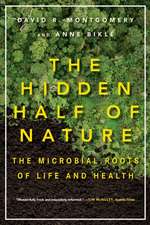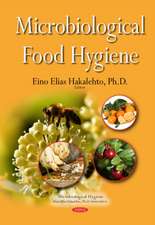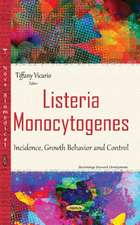The Ecology of Mycobacteria
Autor J. Kazdaen Limba Engleză Paperback – 31 ian 2000
On a more positive side, environmental mycobacteria play an important role in the ecology of moorland dragonflies.
Such a book is needed for specialists working in the field of mycobacterial research, clinical laboratories, the public health service, food hygiene, the water industry and in general ecology.
Preț: 376.04 lei
Nou
Puncte Express: 564
Preț estimativ în valută:
71.96€ • 74.85$ • 59.41£
71.96€ • 74.85$ • 59.41£
Carte tipărită la comandă
Livrare economică 15-29 aprilie
Preluare comenzi: 021 569.72.76
Specificații
ISBN-13: 9780792361978
ISBN-10: 0792361970
Pagini: 72
Ilustrații: VII, 72 p.
Dimensiuni: 160 x 240 x 5 mm
Greutate: 0.13 kg
Ediția:Softcover reprint of the original 1st ed. 2000
Editura: SPRINGER NETHERLANDS
Colecția Springer
Locul publicării:Dordrecht, Netherlands
ISBN-10: 0792361970
Pagini: 72
Ilustrații: VII, 72 p.
Dimensiuni: 160 x 240 x 5 mm
Greutate: 0.13 kg
Ediția:Softcover reprint of the original 1st ed. 2000
Editura: SPRINGER NETHERLANDS
Colecția Springer
Locul publicării:Dordrecht, Netherlands
Public țintă
ResearchCuprins
1. Introduction.- 2. The chronology of mycobacteria and the development of mycobacterial ecology.- 2.1. The microbiology of mycobacteria.- 2.2. The ecology of mycobacteria.- 3. Classification of mycobacteria with regard to their ecology.- 3.1. Environmentally-derived mycobacteria.- 3.2. Obligate pathogenic mycobacteria.- 4. Environments providing favourable conditions for the multiplication and spread of mycobacteria.- 4.1. Mycobacteria in sphagnum vegetation.- 4.2. Occurrence of mycobacteria in bryophytes others than sphagnum.- 4.3. Mycobacteria in aqueous environments.- 4.4. Mycobacteria in soil.- 4.5. Concluding remarks.- 5. Mycobacteria as habitat microorganisms of sphagnum bog vegetation.- 6. Possible convergence towards pathogenicity in environmentally-derived mycobacteria.- 7. The ecological approach to leprosy: Non-cultivable acid-fast bacilli and environmentally-derived Mycobacterium leprae.- 7.1. The implication of sphagnum vegetation to leprosy.- 7.2. Non-cultivable acid-fast bacilli in sphagnum vegetation of former leprosy endemic areas.- 7.3. Differentiation of the non-cultivable acid-fast bacilli.- 7.4. Further examination in coastal Norway using monoclonal antibodies and molecular genetics methods.- 7.5. Isolation of environmentally-derived Mycobacterium leprae from a recent leprosy region.- 7.6. The supporting effect of environmental mycobacteria in experimental leprosy.- 7.7. The environment as a source of leprosy.- 8. Allergic reactions provoked by environmental mycobacteria.- 8.1. Non-specific reactions to tuberculins.- 8.2. Allergic reaction of the digestive tract.- 9. Is the eradication of mycobacterioses possible?.- 10. The prevention of mycobacterial diseases and disorders.- 10.1. Habitats, sources and vectors of mycobacteria.- 10.2. Mycobacterioses caused by Mycobacterium tuberculosis and M. bovis.- 10.3. Prevention of leprosy and Buruli ulcus.- 10.4. Mycobacteria in public water supply systems.- 10.5. Prevention of mycobacterial infection originating in public water systems.- 11. The biological role of mycobacteria in the environment: Mycobacteria as nutrients in the development cycle of moorland dragonflies.- 12. Expected future trends in mycobacteria and mycobacterioses.- References.








